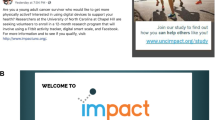Abstract
Young adults have been dramatically underrepresented in cancer survivorship research. One contributing factor is the difficulty recruiting this population. To identify effective recruitment strategies, the current study assessed the yield of strategies used to recruit young survivors for an exercise intervention including: clinic-based recruitment, recruitment at cancer-related events, mailings, telephone-based recruitment, advertising on the internet, radio, television and social networking media, distributing brochures and word-of-mouth referrals. When taking into account the strategies for which we could track the number of survivors approached, recruitment at an oncology clinic was the most productive: 38 % of those approached were screened and 8 % enrolled. When evaluating which strategy yielded the greatest percentage of the sample, however, mailings were the most productive. Given widespread use of the internet and social networking by young adults, investigators should also consider these low-cost recruitment strategies.
Similar content being viewed by others
Notes
Note that another exercise intervention study with cancer survivors also screened 58 % of the survivors contacted (Matthews et al., 2007).
References
Adolescent and Young Adult Oncology Progress Review Group. (2006). Closing the gap: Research and care imperatives for adolescents and young adults with cancer (No. 06-6067). Bethesda, MD: US Department of Health and Human Services, Livestrong Young Adult Alliance.
Bleyer, W. (2006). American Society of Pediatric Hematology/Oncology website. Retrieved July 20, 2006 from http://www.aspho.org/i4a/pages/index.cfm?pageid=481.
Burgess, C., Cornelius, V., Love, S., Graham, J., Richards, M., & Ramirez, A. (2005). Depression and anxiety in women with early breast cancer: Five-year observational cohort study [Electronic Version]. British Medical Journal. Retrieved Mar 26 from http://www.ncbi.nlm.nih.gov/entrez/query.fcgi?cmd=Retrieve&db=PubMed&dopt=Citation&list_uids=15695497.
Callahan, S. T., & Cooper, W. O. (2005). Uninsurance and health care access among young adults in the United States. Pediatrics, 116, 88–95.
Harlan, L. C., Lynch, C. F., Keegan, T. H., Hamilton, A. S., Wu, X. C., Kato, I., et al. (2011). Recruitment and follow-up of adolescent and young adult cancer survivors: The AYA HOPE Study. Journal of Cancer Survivorship, 5, 305–314.
Hewitt, M., & Rowland, J. H. (2002). Mental health service use among adult cancer survivors: Analyses of the National Health Interview Survey. Journal of Clinical Oncology, 20, 4581–4590.
Huddart, R. A., Norman, A., Shahidi, M., Horwich, A., Coward, D., Nicholls, J., et al. (2003). Cardiovascular disease as a long-term complication of treatment for testicular cancer. Journal of Clinical Oncology, 21, 1513–1523.
Hull, M. C., Morris, C. G., Pepine, C. J., & Mendenhall, N. P. (2003). Valvular dysfunction and carotid, subclavian, and coronary artery disease in survivors of hodgkin lymphoma treated with radiation therapy. JAMA, 290, 2831–2837.
Lenhart, A., Purcell, K., Smith, A., & Zickuhr, K. (2010). Social media and mobile Internet use among teens and young adults. Washington, D.C.: Pew Research Center.
Matthews, C. E., Wilcox, S., Hanby, C. L., Der Ananian, C., Heiney, S. P., Gebretsadik, T., et al. (2007). Evaluation of a 12-week home-based walking intervention for breast cancer survivors. Support Care in Cancer, 15, 203–211.
Pinto, B. M., Trunzo, J. J., Rabin, C., Cady, B., Fenton, M. A., Herman, A., et al. (2004). Recruitment strategies for a home-based physical activity intervention for breast cancer patients. Journal of Clinical Psychology in Medical Settings, 11, 171–178.
Shapiro, C. L., & Recht, A. (2001). Side effects of adjuvant treatment of breast cancer. New England Journal of Medicine, 344, 1997–2008.
Travis, L. B., Fossa, S. D., Schonfeld, S. J., McMaster, M. L., Lynch, C. F., Storm, H., et al. (2005). Second cancers among 40,576 testicular cancer patients: Focus on long-term survivors. Journal of the National Cancer Institute, 97, 1354–1365.
US Census Bureau. (2006). Geographic mobility: 2005–2006. Retrieved August 12, 2008 from www.census.gov/population/www/socdemo/migrate/cps2006.html.
Acknowledgments
This research was funded by an award from the National Cancer Institute (5 R03 CA134197-02). We would like to thank Beverly Procopio for her assistance with managing the data for this project.
Author information
Authors and Affiliations
Corresponding author
Rights and permissions
About this article
Cite this article
Rabin, C., Horowitz, S. & Marcus, B. Recruiting Young Adult Cancer Survivors for Behavioral Research. J Clin Psychol Med Settings 20, 33–36 (2013). https://doi.org/10.1007/s10880-012-9317-0
Published:
Issue Date:
DOI: https://doi.org/10.1007/s10880-012-9317-0




